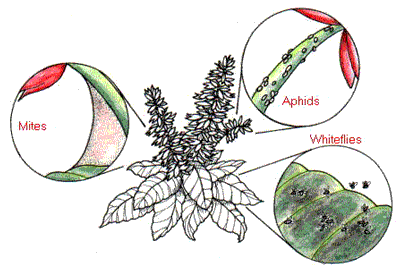 |
Foliage Limp or Yellow Suggests Cultural Problems
Yellow Lower Leaves, Normal Upper Ones Signals Nutritional Deficiency. Even though they are light feeders, sometimes salvia plants are in soil that is not rich enough to sustain them all season. Sprinkle a bit of slow-acting granular fertilizer on the soil around them at the beginning of the season. It will deliver consistent nutrition over the season. Mulch them to protect and improve the soil and to discourage weeds that compete for soil nutrition.
Foliage Hangs Limp And Turns Yellow It Is Likely Lack of Moisture
In the hot summer months even sun-loving annuals like salvia may need watering. If they are not mulched and are in poor soil, run the sprinkler or soaker hose system every week or so if there is no rain in that time. Mulch plants to prevent moisture in the soil from evaporating so quickly. Next year improve the water holding capacity of the soil by digging in some organic matter such as chopped leaves or compost at planting time.
Leaves Discolored And Deformed Means Mites
Red spider mites are about 1/50 inch long, barely visible to the unaided eye. They have 4 pairs of legs, piercing-sucking mouth parts, and very compact bodies. They sometimes attack red salvia. The tops of lower leaves on affected plants are stippled with tiny yellow dots or red spots. Leaves, stalks, and adjacent stems may be distorted or swathed in fine webbing. Foliage becomes discolored and deformed as these pests suck juices from plant cells. Mites typically attack plants that are under stress of some sort.
Sometimes their populations explode when frequent use of broad spectrum insecticides in the area have killed the resident beneficial insects that normally keep mites in check. As soon as you notice these symptoms, spray the plants in the early morning with a forceful water spray to knock the mites off the leaf undersides. Repeat the water spray daily for three days to interrupt their life cycle. If mites persist, spray them with insecticidal soap as directed by the product label. Try and determine what is stressing your salvia plants and correct that problem.
Click here for more information on Dealing_with_Mites.
Flowers, Foliage Curls, Yellows Due To Aphids
Aphids are soft-bodied, pear-shaped, reddish-brown insects a little bigger than the head of a pin. They cluster around tender new plant growth and even inside flowers and suck juices from plant cells. These insects also often secrete a sticky "honeydew" on the foliage that coats it. It, in turn, encourages sooty mold fungus, which then coats the leaves in black. Pinch off tips of young plants where aphids are concentrated and discard them. To treat heavier infestations, spray visible aphids with insecticidal soap. For persistent infestations, spray affected plants with a pyrethrin/pyrethrum insecticide product as directed on the label. Take care to use it late in the day to minimize killing honeybees and other beneficial insects that reside in the yard.
Click here for more information on Dealing_with_Aphids .
Plant Weakens, Leaves Turn Yellow From Whiteflies
Whiteflies are clearly visible on the undersides of salvia leaves. Adult whiteflies are white-winged mothlike insects about the size of a pinhead. When a plant is bumped or brushed they fly up in a cloud resembling flying dandruff. Nymphs and adults suck juices from plant leaves, buds, and stems weakening the plant. As the infestation worsens, the plants themselves weaken and the leaves can begin to turn yellow and die. The undersides of the leaves may be covered with shiny, sticky honeydew secreted by the whiteflies, and a black fungus that is encouraged by the honeydew may appear. Affected plants will become undersized and pale. Spray visible whiteflies with insecticidal soap as directed on the label.
Click here for more information on Dealing_with_Whiteflies.
Ragged Holes In Leaves Means Slugs Or Snails
Slugs are essentially snails without shells. Typically they are 1 to 2 inches long, although some species grow up to 8 inches. They may be white, gray, yellow, or brownish-black. Slugs and snails emerge at night, attracted to moist, well-mulched gardens and acidic soil. They rasp holes with their file-like tongues in a wide variety of plants, and disappear in daylight, often leaving behind a trail of silvery mucous. They hide under boards or leaf litter during the day. Although these pests are always most destructive in shaded gardens and during rainy spells, they may attack red salvia in a sunny bed.
Control slugs by trapping them early in the season when they first appear. Set out commercial slug traps or a pie plate or other shallow container filled with beer in the bed near the salvias. Slugs are attracted to the yeast in the beer, climb in and drown. Begin trapping within the first three to four weeks after the last frost to kill the early arrivals before they can reproduce. If slugs persist, sprinkle Diatomaceous earth (DE) or put slug barrier on the soil around each salvia plant to discourage them.
Click here for more information on Dealing_with_Slugs_and_Snails.
Flower Clusters Covered With Gray Mold Signals Botrytis Blight
A blight disease caused by a fungus sometimes causes water-soaked moldy, soggy spots to form on red salvia plants. Entire flower spikes may be affected, and branches may die back in humid weather. Carefully pinch off affected parts. Wrap and discard them to avoid spreading spores further. If a plant is covered with the mold, pull it up and throw it away. Clean off the soil in the vicinity of any sick plants to eradicate spores which may remain there and infect other plants.

